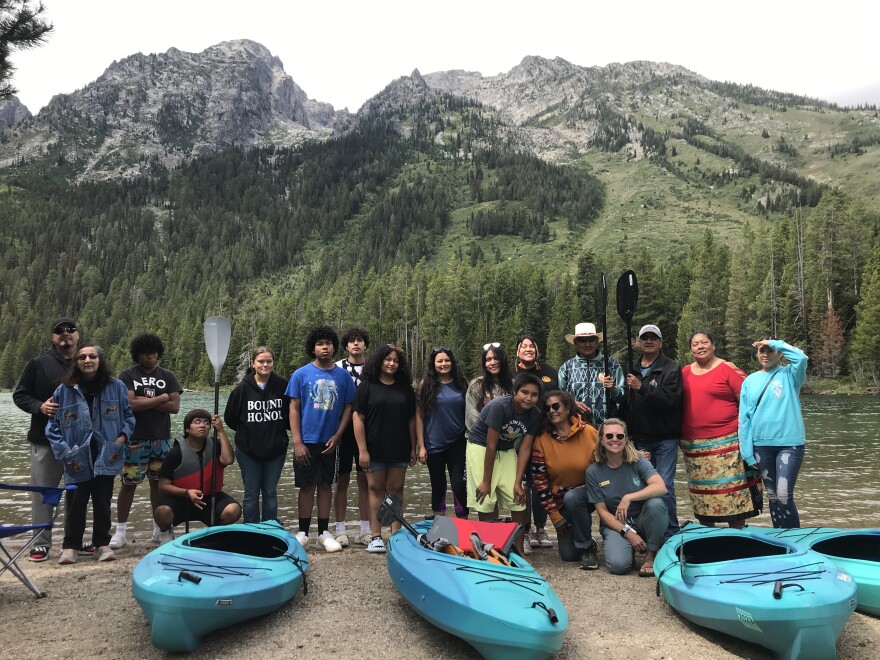A group of young Native leaders reconnected with their ancestral roots through a week-long adventure trip to the Teton and Yellowstone National Parks this August. The trip blended environmental education, intergenerational storytelling, ecological knowledge, cultural preservation, and outdoor exploration.
Thirteen youth from the Wind River Reservation and the Pine Ridge Reservation in South Dakota came on the expedition as part of the Indigenous Youth Voices youth group. They were joined by five traditional elders and teachers from the Lakota, Dakota, Northern Arapaho, Eastern Shoshone, and Blackfeet Nations.
The trip was the first of its kind for the group, which partnered with Yellowstone and Grand Teton National Parks and Teton Science Schools. It included kayaking at String Lake, whitewater rafting on the Snake River, and a wildlife tour through Yellowstone.
Lynnette Grey Bull is the leader of the youth group, which she started in early 2022. The group aims to expose young people to connections with the land and to leadership opportunities with conservation and outdoor recreation partners.
Grey Bull said she hopes these kinds of trips help support the next generation of Indigenous environmental stewards and create pathways into jobs and leadership positions in outdoor education, climate change and conservation.
“I want to create more spaces where our Native youth feel comfortable being out with the National Park, with entities like the Teton Science School and other groups out there that work on the great outdoors and work on environmental protection and climate change,” she said.
Grey Bull, who is Northern Arapaho and Hunkpapa Lakota, said there’s an overall shortage of people working in conservation and climate-oriented fields at large – and that Indigenous peoples’ stewardship-oriented traditions and worldviews are especially crucial for meaningful environmental work.
“We are taught at a young age that we use our medicinal plants during our ceremony times – cedars, sage, red willow and other elements – and every tribe has their own elements of what they use for medicinal and ceremonial practices,” Grey Bull said. “So we understand at a young age how important the earth is, we call animals our relatives.”
Even over the course of a few days, Grey Bull said she saw a noticeable change in the group.
“I hear them talking about ‘How can we get jobs in these areas? What kind of school do we have to go to learn more?’ All of them have told me, ‘Make sure you're calling me on the next trip, you know, make sure to include me,’” she said.
Indigenous people used to inhabit and manage the spaces that have become National Parks and what are now called “public” lands. Yellowstone National Park is no exception – many different tribes interacted with the lands, waters, plants and animals of the area prior to being moved onto reservations by the U.S. government. Their long-lasting legacy of stewardship of the area was also removed from the park’s narrative for many years so that it could be marketed as “pristine” and “untrammeled.”
But despite this history of removal and erasure, Native peoples today continue to have long-lasting and powerful connections to the area – Yellowstone National Park recognizes 27 tribes with historical and contemporary ties to the land and Grand Teton National Park recognizes 24 associated tribes with connection to the lands and resources of the area. An article by Dr. Shane Doyle (Apsáalooke/Crow) on Indigenous place names in and around Yellowstone National Park speaks to a long and rich connection still alive today, and Native artists continue to highlight their contemporary presence in the space through art exhibits like Yellowstone Revealed.
Grey Bull said that, during their wildlife tour in Yellowstone, the group was able to share some of their own knowledge of the area with their wildlife guides in an act of cross-cultural learning.
“It wasn't just them teaching us – we learned a lot from them, but we also were teaching them that this is our ancestral lands. This land, particularly Jackson and Yellowstone and Grand Teton National Park, was our ancestral homelands for the Dakota, Lakota, Eastern Shoshone, Northern Arapaho, Nez Perce and Flatheads and a whole plethora of other tribes. We all have ancestral ties here,” she said.
Throughout the week, the elders and teachers on the trip told traditional stories and emphasized the importance of the oral storytelling tradition. Dr. Tarissa Spoonhunter, a professor of American Indian studies at Central Wyoming College, spoke to the students about the intersections of traditional ecological knowledge and careers in the fields of science, technology, engineering, and math.
Dr. Spoonhunter, who is an enrolled member of the Northern Arapaho Tribe and a descendant of the Blackfoot Confederacy, also led the students in an activity practicing spoken and signed words in Arapaho.
Grey Bull said that creating the space for knowledge to be shared between the different generations who came on the trip was invaluable.
“Not only do we share our language and speak our language, but we also share things that they [the students] probably haven't learned and won't be able to learn in school. Some of our traditional and oral knowledge and historical knowledge, as many people know, is not told in the right way,” she said.
Grey Bull said she hopes the trip can be the first of many more opportunities for connections across generations, lines of work, and walks of life.
“I think it's about time to build those bridges and build those educational spaces so that we can cross-educate and cross-knowledge share,” she said.







